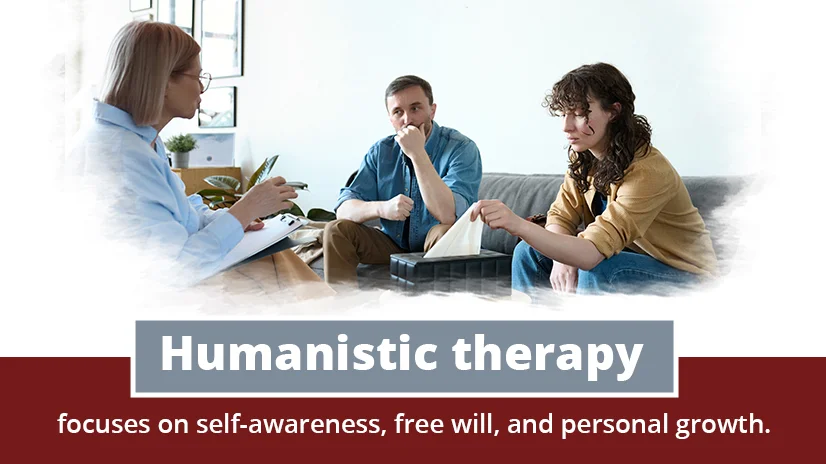
Understanding Narcissistic Personality Disorder (NPD)
Explore the symptoms, causes, and treatments for narcissistic personality disorder with Indiana Center for Recovery.
Therapies for mental health encompass a wide range of approaches designed to improve emotional well-being and manage mental health conditions. These therapies include traditional methods like cognitive behavioral therapy and holistic practices like mindfulness and yoga.
Effective therapy addresses symptoms, fosters resilience, and offers complementary ways to support mental health. These diverse therapies provide comprehensive support by addressing individual needs and helping individuals achieve balance in their mental health journey.
Mental health therapies are key in enhancing emotional well-being and managing mental health conditions. Here’s what you need to know:
Ready to enhance your mental well-being? Contact Indiana Center for Recovery today at (844) 650-0064 to explore effective mental health therapies tailored to your needs.

Mental health therapies provide structured approaches to managing symptoms, enhancing coping skills, and improving overall well-being. These include cognitive behavioral therapy (CBT) to reframe negative thought patterns and psychoanalysis to explore unconscious conflicts.
Mental health therapies are important for addressing a spectrum of psychological challenges, from anxiety and depression to more severe disorders. They provide structured support and tools tailored to individual needs, fostering self-awareness and emotional regulation.
Therapeutic interventions not only alleviate distressing symptoms but also contribute to preventive care, reducing the long-term impact of mental illnesses. Thus, investing in different psychotherapies is crucial for holistic health and societal well-being.
Psychodynamic therapy, a cornerstone of modern psychology, delves deep into the unconscious mind, unraveling layers of hidden thoughts and emotions that shape our daily lives.
Psychodynamic therapy, rooted in Freudian principles, explores unconscious thoughts and past experiences influencing present behavior and emotions. Developed in the early 20th century, it evolved from Freud’s psychoanalysis to emphasize interpersonal relationships in treatment.
Concepts like the unconscious mind, defense mechanisms, and the significance of early relationships in shaping personality are central to psychodynamic therapy. Therapists focus on revealing unconscious patterns to foster insight and promote emotional healing.
Therapists employ techniques such as free association, where clients express thoughts without censorship and interpretation. They also explore transference, where emotions toward others are redirected onto the therapist.
Psychodynamic therapy aims to alleviate symptoms by addressing underlying issues, enhancing self-help, and improving interpersonal relationships. Studies suggest it’s effective for various medical conditions and offers long-term benefits beyond symptom reduction.
Beyond symptom relief, psychodynamic therapy aims for lasting psychological transformation by unraveling deep-seated emotional patterns.
Cognitive behavioral therapy (CBT) is a transformative approach in psychology. It blends cognitive and behavioral techniques to empower individuals to manage their mental health.
CBT is a widely used psychological treatment therapy that focuses on how thoughts, feelings, and actions interact. It originated in the 1960s, merging cognitive therapy, which examines thought patterns, with behavioral therapy, which addresses actions and reactions.
CBT operates on the idea that our thoughts influence our feelings and behaviors. Individuals can modify their emotional responses and behaviors by recognizing and challenging distorted thoughts (cognitive restructuring).
These techniques involve identifying automatic negative thoughts and examining their accuracy and impact. Clients learn to replace distorted thoughts with more balanced and constructive ones, promoting healthier emotions and behaviors.
CBT utilizes behavioral strategies such as exposure therapy, where individuals gradually confront feared situations, and behavioral activation, which encourages engagement in positive activities to counteract depression, anxiety, or similar issues.
CBT has demonstrated effectiveness across various mental disorders. It includes depression, anxiety disorders, and post-traumatic stress disorder (PTSD). Its structured approach makes it adaptable for individual or group settings, promoting long-term symptom relief.
CBT targets negative thought patterns and maladaptive behaviors, offering practical tools for individuals seeking to improve their emotional well-being.
Dialectical behavior therapy (DBT) is a cognitive behavioral therapy designed to help individuals manage intense emotions and develop healthy coping mechanisms.
Dr. Marsha Linehan created DBT in the late 1980s to treat borderline personality disorder (BPD). It combines cognitive-behavioral techniques with mindfulness practices. Initially, it focused on reducing self-harm and suicidal behaviors, but its use has expanded to other mental health issues.
DBT revolves around “dialectics,” balancing acceptance and change. It integrates mindfulness, distress tolerance, emotion regulation, and interpersonal effectiveness. The therapy emphasizes understanding opposing viewpoints and finding a balance between them.
DBT teaches four main skills:
DBT has proven effective in reducing self-harm, suicidal behaviors, and symptoms of borderline personality disorder (BPD). It also helps individuals with depression, anxiety, and substance abuse. Research shows that DBT improves emotional regulation and enhances overall mental health.
By understanding the concepts of DBT and practicing its core skills, individuals can experience significant benefits and positive changes in their lives.
Humanistic therapy is an effective treatment focused on individual growth and self-fulfillment. It emphasizes understanding and improving the human experience.
Humanistic therapy emerged in the 1950s as a response to psychoanalysis and behaviorism. Key figures include Carl Rogers and Abraham Maslow. They emphasized personal potential, self-actualization, and the importance of a supportive therapeutic relationship.
Humanistic therapy focuses on self-awareness, free will, and personal growth. It stresses the inherent goodness of people, the importance of living in the present, and the capacity for self-healing and self-improvement.
Techniques include client-centered therapy, in which therapists provide unconditional positive regard, empathy, and active listening. Gestalt therapy, which focuses on awareness and present-moment experiences, is also commonly used.
Humanistic therapy can enhance self-esteem, foster personal growth, and improve relationships. It has shown effectiveness in treating depression, anxiety, and other emotional issues. It promotes a positive self-concept and emotional resilience.
Humanistic therapy offers a compassionate approach to mental health, helping individuals achieve greater self-understanding and fulfillment.
Eye movement desensitization and reprocessing (EMDR) is a psychotherapy technique used to treat trauma and other distressing life experiences. It helps patients process and integrate traumatic memories.
Francine Shapiro developed EMDR in the late 1980s. She discovered that eye movements could reduce the intensity of disturbing thoughts, leading to the development of this therapy.
EMDR involves processing traumatic memories by using bilateral stimulation, such as side-to-side eye movements. This helps the brain reprocess the trauma, making it less distressing.
Techniques in EMDR include bilateral stimulation (e.g., eye movements, tapping), cognitive restructuring, and desensitization to traumatic memories. These help patients reprocess and heal from their trauma.
EMDR is effective in lessening symptoms of PTSD, anxiety, and depression. It helps patients process traumatic memories, leading to reduced emotional distress and improved mental health.
EMDR is a powerful therapy that helps persons heal from trauma by reprocessing distressing memories. Its effectiveness and structured approach make it a valuable method in mental health treatment.
Group therapy involves treating multiple patients simultaneously within a group setting. It’s designed to help individuals improve mental health by sharing experiences and supporting one another.
Group therapy originated in the early 20th century. It gained popularity during World War II to address soldier trauma. Over time, it evolved into a common treatment for various mental health problems.
Key concepts of group therapy include peer support, shared experiences, and interpersonal learning. Through group interactions, participants benefit from mutual support and gain insights and coping strategies.
Group therapy sessions typically last 1-2 hours, with 6-12 members led by a trained therapist. Sessions follow a structured format, often focusing on a specific theme or goal, with opportunities for discussion and feedback.
Group therapy is beneficial for reducing symptoms of depression, anxiety, and other mental health conditions. It provides a supportive environment, enhances social skills, and helps individuals feel less isolated.
Overall, group therapy is a useful tool for mental health recovery. Fostering a sense of community and shared understanding helps individuals navigate their challenges together.
The most common therapy for mental health is cognitive behavior therapy (CBT). It is a widely used, evidence-based therapy that helps persons identify and change negative thought patterns and behaviors. It is useful for a variety of mental illnesses, including depression, anxiety, and PTSD.
CBT is a type of talk therapy that involves structured sessions with a therapist. In these sessions, patients learn coping strategies and problem-solving skills. CBT’s popularity stems from its adaptability, clear structure, and extensive research supporting its effectiveness in improving mental health outcomes.
To choose the best type of therapy, start by identifying your specific needs and goals. Research different approaches, such as cognitive behavioral therapy (CBT), dialectical behavioral therapy (DBT), or psychodynamic therapy, to understand their focus and techniques.
Consider personal preferences, such as the desire for structured sessions or a more open-ended approach. Consult a mental health professional who can analyze your situation and recommend suitable options. Ensure the therapist is qualified and experienced in treating your specific issues, and feel free to try different therapists to find a good match.
During your first session in therapy, expect to discuss your reasons for seeking help, current concerns, and personal history. The therapist will ask questions about your background, symptoms, and goals. This initial meeting is an opportunity to build rapport and establish a comfortable, trusting environment.
You may complete some paperwork and discuss confidentiality and the structure of future sessions. The focus will be creating a treatment plan tailored to your needs, so be open and honest. It’s normal to feel nervous, but this session sets the foundation for your therapeutic journey.
At Indiana Center for Recovery, we offer various mental health treatment services. Our inpatient psychiatric program is designed to treat a variety of mental health conditions effectively.
Our treatment options include cognitive behavioral therapy (CBT), which focuses on modifying negative thought patterns, and dialectical behavior therapy (DBT), incorporating mindfulness and emotion regulation techniques. In addition, we provide eye movement desensitization and reprocessing (EMDR), a treatment for processing traumatic memories.
We also offer family programs to strengthen family relationships, individual therapy tailored to personal needs, and group therapy sessions for mutual support and skill development.
Contact us today at (844) 650-0064 to learn how to begin your journey toward a healthier life.
